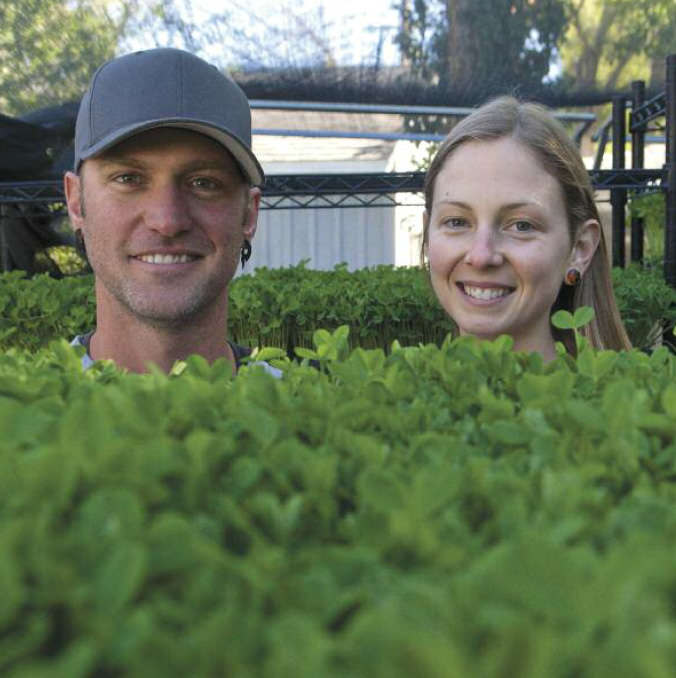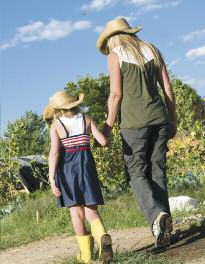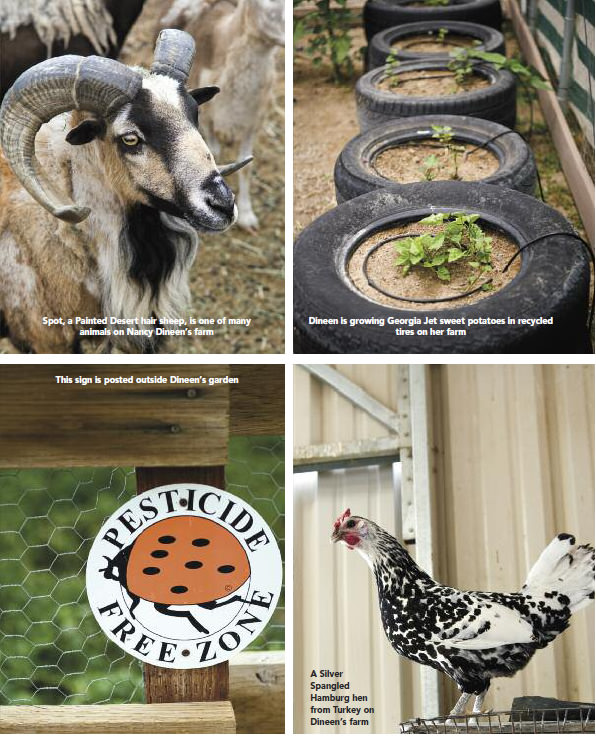meet the farmer
NO SMALL POTATOES
Winnemucca Farms maintains local roots, while morphing into one of Nevada’s largest farms.
WRITTEN BY KELSEY FITZGERALD
PHOTOS BY CANDICE NYANDO
On a warm April morning, farm manager Tim Topliff drives a long dirt road at Winnemucca Farms, his phone buzzing with incoming messages. Alongside him, freshly planted pea fields alternate with soon-to-be-planted fields of potatoes, and herds of beef cattle graze upon acre after acre of bright green winter wheat.
Topliff points to a long line of sprinklers set on wheels — one of the farm’s many pivot irrigation systems.
“If you hear my phone beeping a lot, it’s because I get text messages when the pivots start and stop,” he says.
The irrigation system, which can be turned on and off by smartphone, is just one of many ways that life at Winnemucca Farms has changed in recent years. For Topliff, keeping tabs on the farm’s 15,000 planted acres of potatoes (chippers for potato chips and russets for seed), green peas, alfalfa, wheat, and other crops is no small task, even with the aid of technology — but technology certainly helps.

Evolution of a farm
Winnemucca Farms, located about 15 miles north of Winnemucca, Nev., was founded during the 1970s by the Kracaw family of Idaho, who moved to the area to farm potatoes. In 1999, the Kracaws sold the farm to North Dakota-based R.D. Offutt Co. — the world’s largest potato-growing company, according to Forbes magazine, growing 50,000 acres of potatoes across nine states each year — and potato cultivation continued under new management.
As times changed, so did life on the farm. New crops were added, including wheat, alfalfa, and green peas. Irrigation lines, once hand-moved each day by a crew of more than 250 farm workers, were transferred to a telemetry-based system that can be operated by a small team of irrigators from their smartphones.
Efficiency became a priority. New groundwater pumps were installed, with flow meters and a computer-based monitoring system for tracking water use — especially important during drought years. A GPS-guided system, pre-programmed to plow and plant fields with sub-inch accuracy, replaced planting machinery. Topliff even can monitor his operators’ progress from his office computer.
“The guy running the planter,” Topliff says. “I can tell you how fast he’s planting, how many acres an hour, how often he stops.”

Looking forward
Today, Winnemucca Farms is one of the largest farms in the state, employing 50 to 60 year round and 80 to 100 during harvests, with resources spread across three different properties near Winnemucca and Orovada, Nev. (the latter property — close to the Oregon border — is where the company’s seed potatoes and seed wheat are grown). Though its produce is not sold at local farmers’ markets, the farm is a contract grower of 1,500 acres of potatoes for the Frito-Lay chip company and 5,000 acres of green peas for Snapea Crisps, a snack product available at Trader Joe’s, Costco, Raley’s, and other supermarkets.
New projects are in the works. The farm recently began a transition to production of organic alfalfa, which is used to feed organic dairy cows. Also, as part of Winnemucca Farms’ beef cattle grazing program, ranchers pay to graze their cattle on the farm’s fields of wheat.
Topliff and his team members are experimenting with other grazing crops, such as forage corn and turnips.
“We’re always changing everything up,” Topliff says. “Every day, we’re doing something different.”
Winnemucca Farms’ leaders also believe in giving back. Topliff says they have donated potatoes to many charitable events, such as the annual FFA banquet. And they donate and sponsor many other charitable events around the county and state.
“We are also working with organizations for wildlife habitat and conservation efforts,” he says.
For Topliff, who grew up on a farm in Idaho, being part of such an operation has been a lifelong dream. After obtaining a bachelor’s degree in agricultural economics and a master’s degree in crop science, Topliff worked for several years as an agronomist before being offered a job with Winnemucca Farms’ Orovada property in 2012. He became farm manager for the entire operation early this year. He manages and lives at Winnemucca Farms with his wife, five children, chickens, cattle, hogs, and hunting dogs.
“I have two little boys, and all they want to do is farm,” Topliff said. “They’re like me. All I’ve ever wanted to do in life was farm.”
Kelsey Fitzgerald is a freelance writer in Reno. She enjoys stories about the outdoors, environment, and people of the Great Basin and Sierra Nevada.
Recipe
Hot German Potato Salad
(courtesy of Elizabeth Topliff. Serves 12)
Tim Topliff’s wife, Elizabeth, makes this hot potato salad, which is Tim’s favorite potato dish. Elizabeth credits this recipe to a friend, Anita Gianotto.
Note: Yellow potatoes are best. Do not rush! You can peel the potatoes or leave peels on.
9 potatoes, cut into bite-sized pieces after boiling them
6 slices bacon
¾ cup chopped onion
2 tablespoons cornstarch or flour
2 tablespoons sugar
1 teaspoon salt
½ teaspoon celery seed
⅛ teaspoon ground black pepper
¾ cup water
⅓ cup apple cider vinegar
Boil potatoes until tender but firm. Drain. Place in refrigerator overnight (will be mushy if made the same day).
Cook bacon in skillet over medium heat until brown. Drain, crumble, and set aside. Reserve drippings. Sauté onion in bacon drippings until golden brown. In small bowl, whisk flour (or cornstarch), sugar, salt, celery seed, and pepper. Add to onions and cook until bubbly. Remove from heat, stir in vinegar and water, and return to stove. Add bacon and pour over potatoes. Bake at 350 degrees F for 30 minutes to warm potatoes. Stir periodically.


